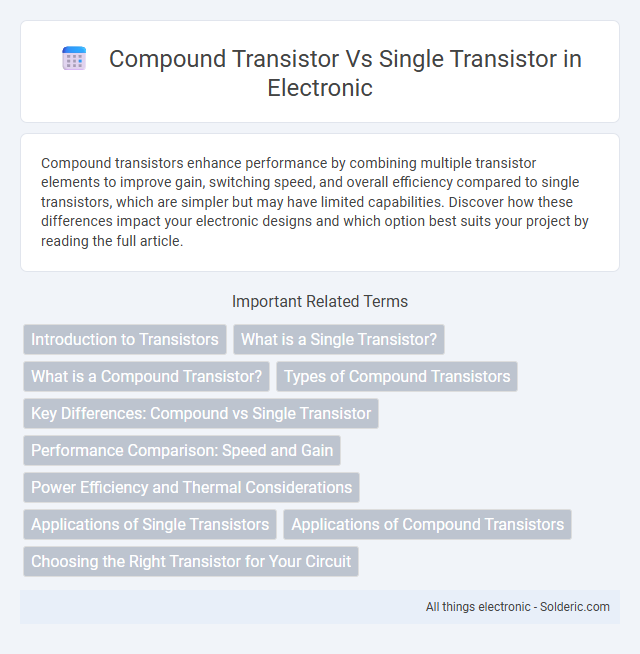Compound transistors enhance performance by combining multiple transistor elements to improve gain, switching speed, and overall efficiency compared to single transistors, which are simpler but may have limited capabilities. Discover how these differences impact your electronic designs and which option best suits your project by reading the full article.
Comparison Table
| Feature | Compound Transistor | Single Transistor |
|---|---|---|
| Structure | Combination of two or more transistors | Single semiconductor device |
| Gain | Higher current gain (b product of multiple transistors) | Lower current gain (b of one transistor) |
| Power Handling | Better power amplification capability | Limited power handling |
| Switching Speed | Typically slower due to complexity | Faster switching speed |
| Application | Used in push-pull amplifiers, Darlington pairs, and high-gain circuits | Used in simple amplification and switching circuits |
| Complexity | More complex circuit design | Simpler design and implementation |
| Cost | Higher cost due to multiple components | Lower cost, single device |
Introduction to Transistors
Transistors, fundamental semiconductor devices, control current flow in electronic circuits. Single transistors typically regulate current with one active junction, while compound transistors combine multiple transistor elements to enhance performance parameters like gain and switching speed. Compound configurations, such as Darlington pairs or Sziklai pairs, offer higher current amplification and improved input-output isolation compared to single transistors, making them ideal for high-performance applications.
What is a Single Transistor?
A single transistor is a semiconductor device used to amplify or switch electronic signals, consisting of three layers of semiconductor material forming either NPN or PNP types. It functions as a basic building block in electronic circuits by controlling current flow through a single junction, enabling simple amplification or switching tasks. Understanding your single transistor's characteristics, such as gain and switching speed, is essential for optimizing its performance in diverse electronic applications.
What is a Compound Transistor?
A compound transistor, also known as a Darlington transistor, consists of two or more transistors connected to provide higher current gain than a single transistor. This configuration amplifies the input current through multiple transistor stages, resulting in greater overall amplification and sensitivity. Your choice between a compound transistor and a single transistor depends on the required current gain and switching speed for your application.
Types of Compound Transistors
Compound transistors include bipolar junction transistors (BJTs) combined in configurations such as Darlington pairs, Sziklai pairs, and cascode amplifiers to enhance current gain, bandwidth, and input-output isolation compared to single transistors. Darlington pairs feature two BJTs connected to provide extremely high current gain, ideal for switching and amplification in high-current applications. Sziklai pairs offer similar gain with lower saturation voltage, while cascode arrangements improve frequency response and reduce Miller effect, enhancing your circuit's performance in high-frequency domains.
Key Differences: Compound vs Single Transistor
Compound transistors combine multiple transistor elements to enhance performance parameters such as gain, switching speed, and power handling, whereas single transistors consist of only one transistor element with simpler architecture. Compound transistors offer superior current amplification and thermal stability, making them ideal for complex circuits requiring higher efficiency and lower distortion. Your choice between compound and single transistor depends on the specific requirements of power, frequency response, and circuit complexity.
Performance Comparison: Speed and Gain
Compound transistors, such as Darlington pairs, exhibit higher current gain compared to single transistors, enabling amplified signal strength ideal for high-gain applications. Single transistors typically achieve faster switching speeds due to lower input capacitance and reduced charge storage, making them preferable in high-frequency circuits. The trade-off between speed and gain dictates the choice: compound transistors favor applications requiring enhanced amplification, while single transistors excel in faster switching performance.
Power Efficiency and Thermal Considerations
Compound transistors, such as Darlington or Sziklai pairs, exhibit improved power efficiency by providing higher current gain compared to single transistors, reducing the input current requirement and minimizing losses in driver circuits. Thermal considerations are critical for compound transistors due to increased power dissipation within multiple junctions, necessitating enhanced heat sinking and thermal management to prevent thermal runaway and maintain reliability. Single transistors typically offer simpler thermal profiles but may require higher base drive current, leading to less efficient power usage in high-current applications.
Applications of Single Transistors
Single transistors are widely used in amplification circuits, switching applications, and signal modulation due to their simplicity and cost-effectiveness. They form the core components in devices like radios, audio amplifiers, and digital logic circuits, where precise control of current flow is essential. Your electronic projects can benefit from single transistors when you need straightforward control and amplification of electrical signals without the complexity of compound transistor configurations.
Applications of Compound Transistors
Compound transistors, such as Darlington pairs or Sziklai configurations, offer higher current gain and improved switching performance compared to single transistors, making them ideal for applications requiring high amplification and power efficiency. They are frequently used in audio amplifiers, motor controllers, and voltage regulators where enhanced gain and stability are crucial. Your circuits benefit from compound transistors in scenarios demanding precise control and robust output without sacrificing compactness or thermal management.
Choosing the Right Transistor for Your Circuit
Selecting the right transistor involves understanding the differences between compound transistors, such as Darlington pairs, and single transistors, where compound transistors provide higher current gain and improved switching performance ideal for high-power amplification. Single transistors are preferred in low-noise, high-frequency applications due to their simpler structure and faster response time. Key parameters to consider include current gain (hFE), switching speed, voltage ratings, and power dissipation to optimize circuit efficiency and reliability.
Compound transistor vs Single transistor Infographic

 solderic.com
solderic.com